Argentina 2000/2001: Aconcagua, J.S. Milne
The top of the Aconcagua can be a sweet lady if Phoebus shines and Eolus sleeps. But when the fury of the god of winds is unleashed and the cloud dragons swallow the sky, the summit is transformed into a terrifying and freezing witch.
From aconcagua.com.
Aconcagua (6962m, 22,841ft) lies in Argentina, near the border with Chile, and only 150 km (90 miles) from the Pacific ocean. It is the highest mountain outside Asia.
The normal route follows the Horcones valley to the west of the mountain, and climbs the north-west face. Except when it is covered with snow, there is a trail most of the way. Because of this, the normal route attracts two to three thousand climbers a year.
By contrast, its south face has challenged some of the world's greatest mountaineers --- it has been described as two Eiger north faces on top of each other.
Fortunately, there are other routes whose difficulty lies between these two extremes.
I planned to approach the mountain via the Vacas valley to its east, and attempt the Polish glacier direct, a route of only moderate difficulty on its north-east face, and then cross over, and descend the normal route and exit by the Vacas valley, thereby circumnavigating the mountain.
Although conventional storms are not very common in summer, high winds are and seem to have grown worse in recent years. Particularly feared is the "viento blanco" (white wind) --- a lenticular cloud that hovers over the summit and signals very high winds and snow even when lower on the mountain it may be sunny and even pleasant.
I planned to spend four days acclimatizing in the Vallecitos region, an area about 80km from the Argentine city of Mendoza, and then eleven days attempting the ascent and circuit of Aconcagua.
Vallecitos
Thanks to Northwest Airlines, the four days I had planned became three. I arrived at Mendoza airport on the morning of December 27, 2000, and only three hours later I was ready to start hiking at Vallecitos --- in the interim, I had purchased some gas bottles and acquired my Aconcagua climbing permit. That night I slept at 3500m (11,500ft). The following day walked up to c.4550m (c. 15000ft) on Pico Franke. After a second night at 3500m, I moved my camp to 4300m (14,100ft). There I met a group of Argentine climbers who had attempted Co. Plata, a peak whose altitude is anywhere between 5800m and 6300m (19,000ft and 20660ft) depending on which map you look at, but had been prevented from reaching the summit by high winds. On the way to the camp, I saw a guanaco (wild relative of the llama), and that evening an impudent fox came round the camp licking the stones where I had peed only a few metres from my tent. On my last day in Vallecitos, I climbed to 4900m (16,100ft) towards Co. Plata and descended back to road, in time to catch my ride to Los Puquios near Aconcagua, the base of the mule owner Rudy Parra with whom I'd contracted.
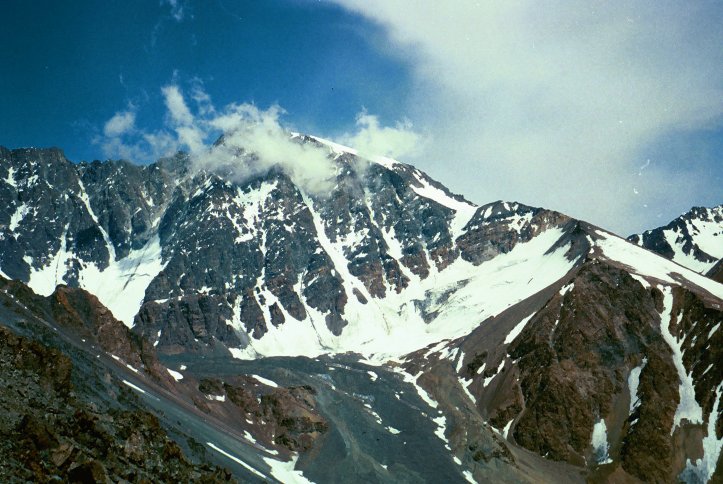
Vallecitos is an interesting little climbing area, but the routes seem to be all very easy or rather difficult. This is Co. Rincon 5500m (18,000ft). The easy route follows the right hand ridge, while the difficult "Supercanaleta" route climbs the ice couloir in the centre of the face.
Up the Vacas
Dec 31. Normally, parties take three days to walk into the base camp "Plaza Argentina" on the Vacas valley (east) side of Aconcagua, but I'd decided to do it in two, partly because I was already somewhat acclimatized. Rudy Parra's foreman grumbled as he drove me to the start of the Vacas valley at 7am --- "No-one else leaves until 9am", he said. After a long walk, I reached Casa de Piedra 3200m (10,500ft) at 6:30pm.Jan 1.I crossed the cold Vacas river and climbed the beautiful Relinchos valley to Plaza Argentina 4200m (14,000 ft).
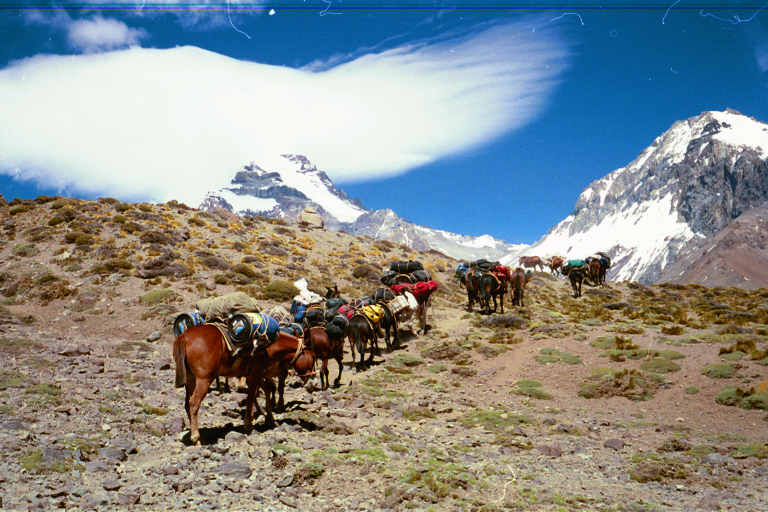
The mules don't go above base camp, thereby showing that they are smarter than me (but not so stubborn).
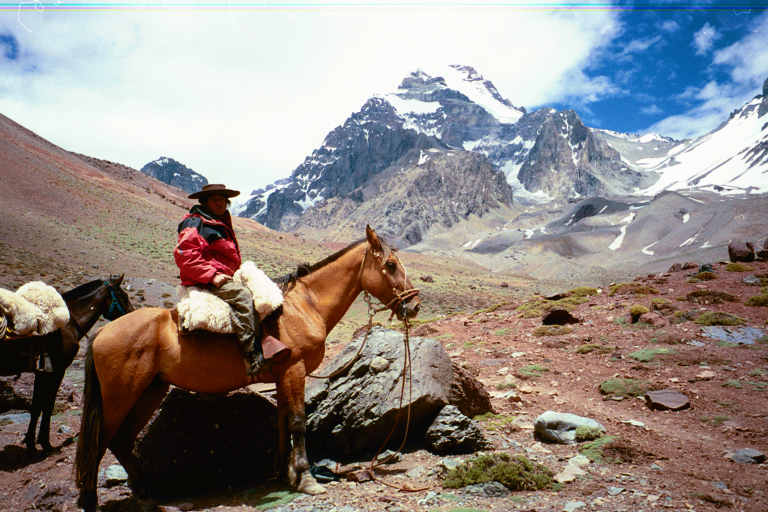
I reached Plaza Argentina about 2pm, and met Daniel, Rudy Parra's friendly representative. After I ordered a cheeseburger and coke from him ($13) he told me "My house is your house.".
At Camp 1
Jan 2. After only one night at Plaza Argentina, I moved up to Camp 1 (5000m, 16,400ft).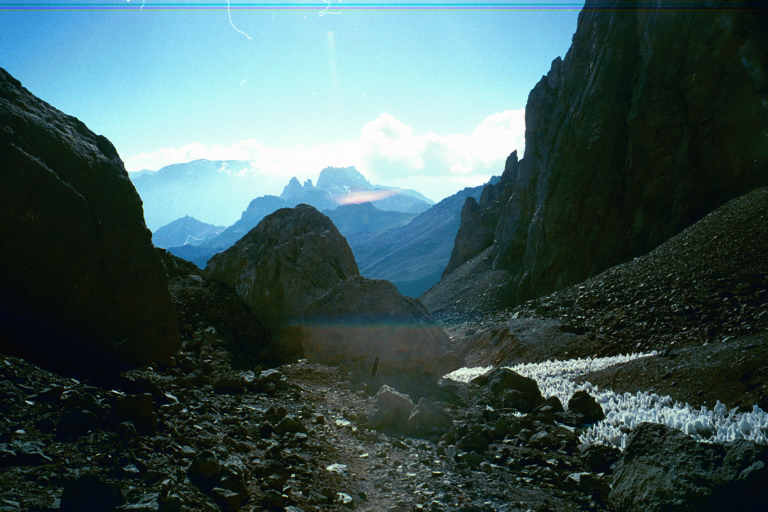
Jan 3. I went down to Plaza Argentina to collect the 15kg of food and gear that Rudy Parra's mules had carried in for me, and returned to Camp 1. I had intended to eat another of Daniel's cheeseburgers, but after thinking about the US guidelines for the care of hamburger meat, I settled on a pancake. On the descent to Plaza Argentina, I heard a helicopter, which Daniel told me evacuated a climber with pulmonary edema from Base Camp. (About 60% of the climbers on Aconcagua get altitude sickness.)

That night it was very windy, and two tents were destroyed at base camp.
Jan 4. I carried a load from Camp 1 up to Camp 2.
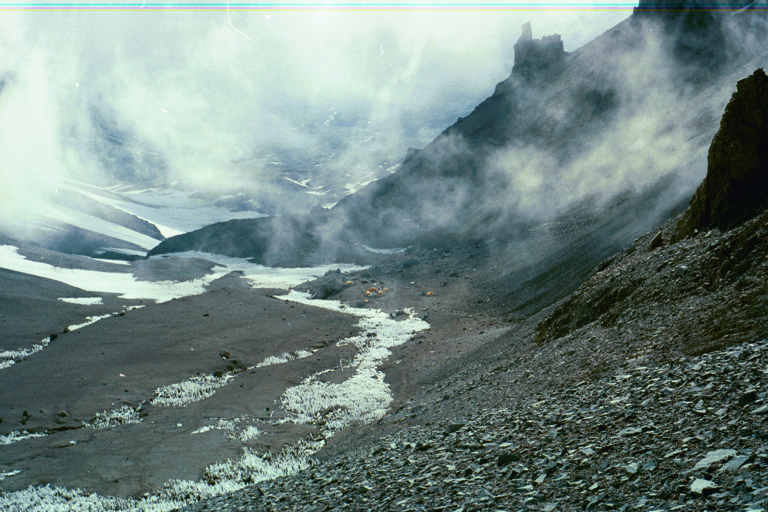
View looking back at Camp 1 on the climb to Camp 2
At Camp 2
Jan 5. I moved to Camp 2 (5900m, 19,350ft).
My tent at Camp 2. The rocks didn't seem to shelter it much from the wind, but they did direct it to blow end on, otherwise my tent may have been destroyed in the following days. Note the large boulders I'm used to secure my tent to the mountain --- the boulders didn't move, but two guy ropes snapped.
My plan was to spend three days, January 6,7,8, at Camp 2, and then exit via the Horcones on January 9 and 10. If the weather was really good on Jan 6, I would attempt the summit, but otherwise I would spend the day resting and acclimatizing. This would leave only Jan 7 and Jan 8 as possible summit days.
From the time I arrived at Camp 2, the barometer fell steadily.
Jan 6. It was windy in the morning, and so I spent the day resting.
Jan 7. The winds were low in the morning, and so I set off for the Polish direct.

View looking up at the Polish direct route from about 6100m (20,000). The route climbs directly up the snow/ice, passing the vertical rock cliffs on the left and the vertical ice cliffs on the right. At its steepest, it is about 50 degrees.
Unfortunately, as I reached the snow the wind rose again, and snow could be seen blowing off the east ridge at the top of the face (see the centre of the picture). It didn't seem wise to continue solo on such a route in a high wind. By early afternoon, the viento blanco had descended on the summit again.
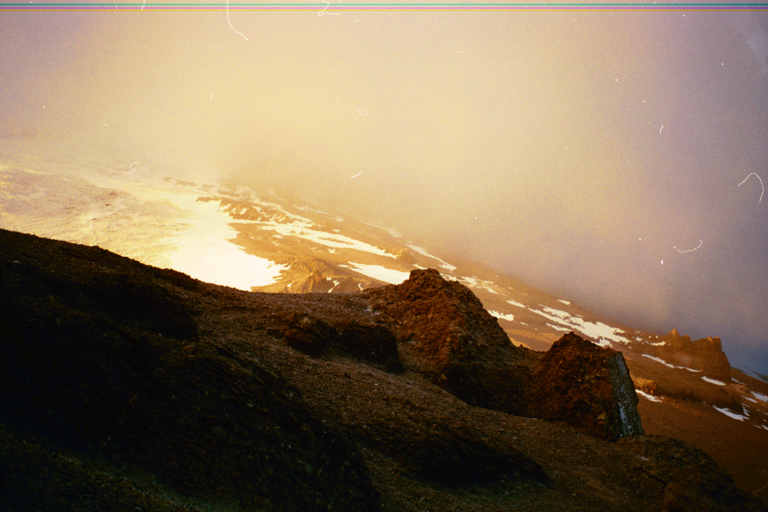
Cloud and high winds, as the sun sets on the evening of January 7 --- the view looking west from my tent door.
That night, the wind was ferocious.
Jan 8. Next morning, the wind continued battering my tent. There was no chance of a summit bid.
During the afternoon, the barometer finally rose a little --- 490, 491, 492, 493 mbars (versus about 1030 at sea-level). I began to have hope that January 9 might be a good day. If so, I decided that, instead of cutting across to the normal route at about 5500m and descending to the Horcones base camp, I would carry my pack up to the normal route at 6300m (20660ft), drop my pack, make a summit attempt, and then descend to the Horcones base camp.
Unfortunately, later in the afternoon, the barometer fell again.
Last summit attempt, and exit
Jan 9. The day dawned very windy and cold (6F, -13C in my tent), but I decided nevertheless to attempt to reach the summit. Striking camp was difficult in such extreme conditions, and I was happy to leave at 7:20, only 20 minutes later than I'd planned, and with the loss of only one stuff sac to the wind (and no frostbite).
As I climbed up toward the junction of with the normal route, I could see, looking back, that only two tents remained at Camp 2 out of the dozen or so that had been there when I arrived --- the camp had been abandoned to the wind. Shortly, I passed the four climbers from the tents, returning from their unsuccessful bid for the summit. The wind was strong enough to threaten to throw me to the ground with every major gust. A sleeping pad flew high overhead, blown from the normal route, still a kilometer to the west.
In 2 1/2 hours I reached the normal route (6300m, 20,660ft). There was a tent pitched precariously there. One of its occupants was climbing half way up the slope ahead, and the other left as I arrived. A third climber was sitting down part way up the slope with a boot off rubbing his toes.
I took off my pack, and put the few essentials I'd need for the climb in the pockets off my down jacket. Without the pack, the wind would affect me less, and I didn't need a pack to carry spare clothing since I was wearing everything I had: t-shirt, turtleneck, Polartec 100 turtleneck, down waistcoat, Polartec 200 jacket, heavy Marmot 8000 down jacket; North Face down gloves; Polartec 200 long johns, windproof trousers; long gaitors; double plastic Lowa Civetta Extrem climbing boots with two pairs of socks.
I set off up the slope, and soon passed the first climber. As I approached the seated climber, he muttered something, put his boot back on, and headed down. Towards the top of the slope I passed the final climber. As I did so, I saw his lips moving, but the noise of wind was too great for me to hear what he was telling me.
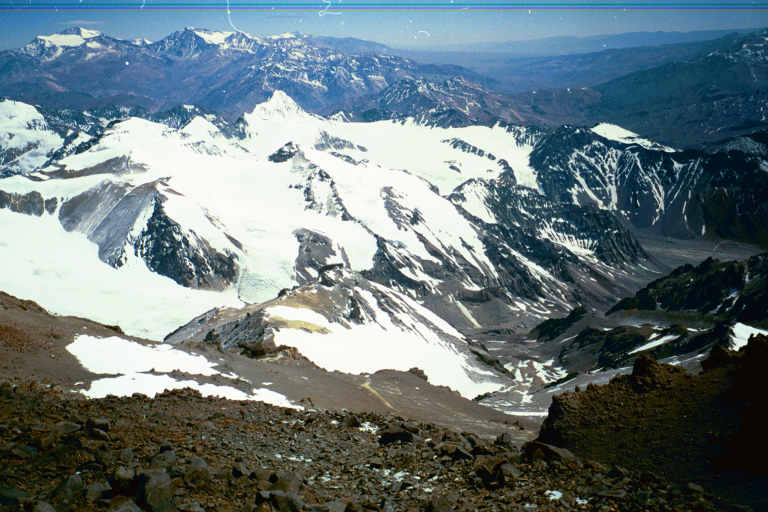
View down the slope from about 6500m (21300 ft). The normal route roughly follows the ridge in the centre of the picture, and then cuts down to the left.
I crossed over a small spur and passed the world's highest refuge, Refuge Independencia 6546m (21,476ft), a ruined wooden box in the shape of a pup tent and not much larger, and continued upward toward the ominously named Cresta del Viento (windy crest).
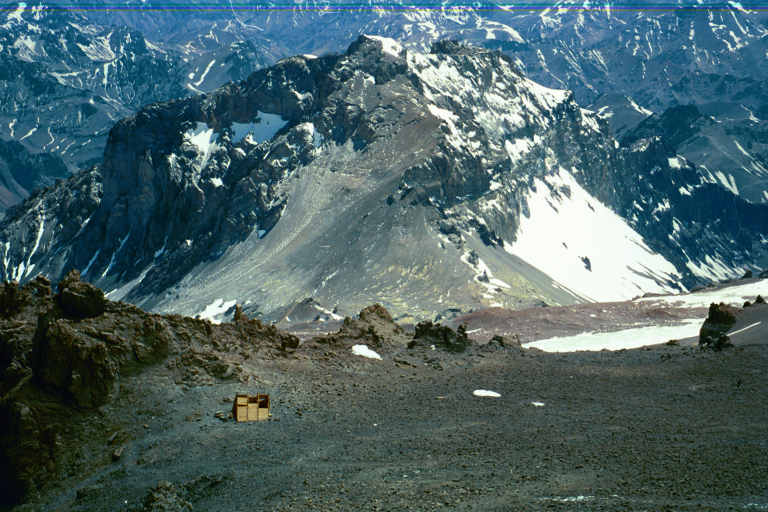
Refugio Independencia 6546m (21,476ft) from near the windy crest. The peak behind is Ameghino (c6000m, 19700 ft).
On the windy crest, the wind was pouring up the northwest face of Aconcagua in a constant powerful stream (my estimate: 130--160kph, 80--100mph; temperature 0F, -18C). I decided to cross the windy crest in the hope that conditions would be better on the other side. Rather than walk on the trail, which was near to top of the crest, I simply walked across the 30 degree slope. The wind was so strong that I felt as though I was walking perpendicular to the slope.
On the other side there were no tracks in the snow on the trail, which indicated that I had gone higher than anyone else that day. I sheltered behind a small pinnacle out of the wind. Unfortunately, the wind hadn't relented, and appeared to be as powerful all the way the summit. Thus, I had no choice but to abandon the climb (at about 6650m, 21,800ft, a little after 11am). To continue would be extremely dangerous: apart from the risk of frostbite (see below!), moving in the wind required most of my strength; if I tired, or the wind intensified, I risked being trapped on the upper part of the mountain.
I descended to my (20kg) pack, and continued down the normal route. Every sheltered spot seemed to harbour a tent. A North Face dome tent had broken from most of its ties, and was flapping in the wind, destroying itself, and shedding its contents to the wind.
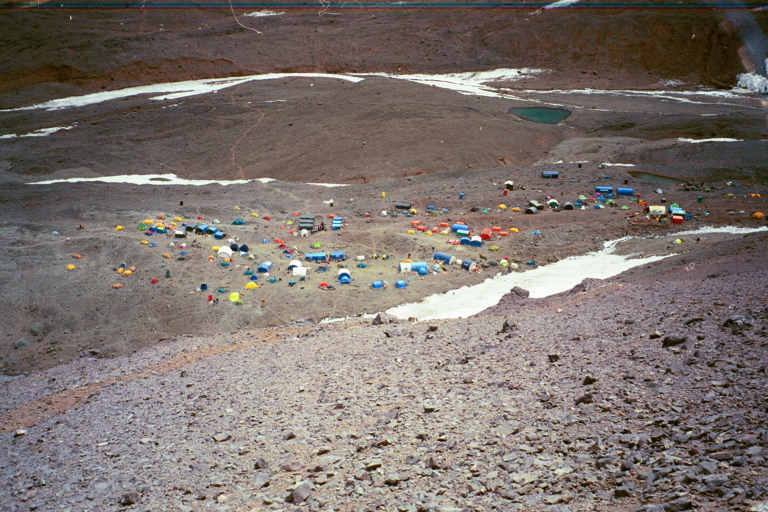
About 3pm I reached the comfort of the Horcones base camp, Plaza Mulas, 4400m (14,432).
When I took my gloves off I was surprised to find a blister on my right little finger, and two on my left, evidently caused by the cold. The next morning (January 10) the two blisters on the left finger had become one, and it was looking rather ugly. I left early, and reached the road at 2:45, where a doctor with the Aconcagua Park Service diagnosed it as second degree frostbite. Happily, that's not as dramatic as it sounds: 7 days later (January 17) the blisters have drained themselves without breaking and the frostbite is essentially healed; 21 days later (January 31)apart from a slight redness, there is no sign that I had frostbite.
------------------
For many mountaineers, perhaps the best mountaineers, a trip is a totally failure if they don't reach the summit. I am not one of them: for me, except for some catastrophe, a trip to the mountains can hardly be a failure; simply being in the mountains is what I enjoy; reaching a summit is a bonus.